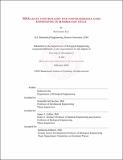RNA-level controllers for programmable gene expression in mammalian cells
Author(s)
Ilia, Katherine
DownloadThesis PDF (33.11Mb)
Advisor
Del Vecchio, Domitilla
Collins, James J.
Terms of use
Metadata
Show full item recordAbstract
Synthetic biology is a burgeoning field that aims to design circuits using biomolecular components in order to equip cells with desired functionality for a variety of applications, such as medicine, biofuel production, and environmental health. As this field matures, engineers are taking on challenges that require the integration of regulatory logic in complex environments. While there has been significant progress in synthetic biology, there remains a need for genetic devices that allow for precise control over endogenously and exogenously expressed genes. Here, through two examples, we demonstrate that RNA is well-suited for engineering compact, programmable biomolecular tools with sense and actuate functionalities. In the first half of this thesis, we develop a microRNA-based strategy to precisely overwrite the expression level of an endogenous gene of interest, thereby insulating the expression levels of this gene from interference by the endogenous transcriptional unit. We incorporate this strategy into genetic controllers and leverage live cell imaging to develop a versatile strategy for probing the role of transcription factor dynamics on and enforcing the levels of transcription factors in cell fate transitions. In the second half of this thesis, we engineer programmable single-transcript RNA sensors in vivo, in which adenosine deaminases acting on RNA (ADARs) autocatalytically convert target hybridization into a translational output. This system amplifies the signal from editing by endogenous ADAR through a positive feedback loop. This topology confers high dynamic range, low background, minimal off-target effects, and a small genetic footprint. We anticipate that these approaches have extensive applications in cell- and RNA-therapeutics as well as for basic research, illustrating the potential of programmable RNA-based controllers.
Date issued
2023-02Department
Massachusetts Institute of Technology. Department of Biological EngineeringPublisher
Massachusetts Institute of Technology